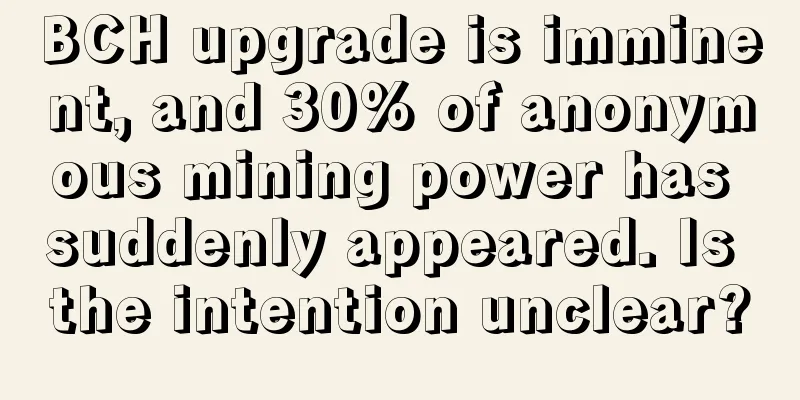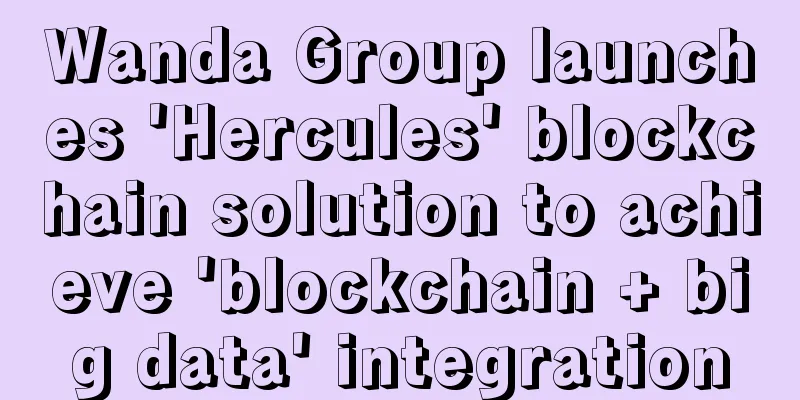BCH upgrade is imminent, and 30% of anonymous mining power has suddenly appeared. Is the intention unclear?

|
If the blockchain industry were written into a story, the Bitcoin world would be like the continent of Westeros, where long summers alternate with bitter winters, and the magic of the God of Light and the God of Cold wax and wane, just as the prosperity and decline of Bitcoin keep alternating. BCH (Bitcoin Cash) is about to upgrade on Wednesday this week, and a large amount of anonymous computing power on the BCH network has attracted everyone's attention. The anonymous computing power started on April 21, 2019, and has mined 629 blocks so far, with a total of 7,865.7 BCH. The Coinbase information has changed from "boomboomboom" to "Satoshi Nakamoto". These anonymous computing powers are about 754P, accounting for 32% of the entire BCH network. No one knows where this computing power comes from. From the BCH computing power trend chart below, we can see that anonymous computing power (the gray part in the figure) accompanies the entire process of BCH development, and its proportion varies greatly in different stages. Source: coin.dance In fact, anonymous computing power exists in the BTC/BCH/BSV networks (as shown in the figure below). However, the proportion of anonymous computing power in BCH is usually higher than that in the other two. Source: coin.dance There are many reasons for hiding computing power, such as not wanting to publicly mine BCH for privacy reasons. It is often difficult to say whether this kind of computing power is friendly or hostile, but one thing is certain, computing power is profit-seeking, mining has costs, and no one will do a business that loses money in the long run. Therefore, anonymous computing power switching to BCH mining may be chasing higher returns. According to data on May 12, BCH's revenue was 2.02 yuan/TH, higher than BTC's 1.88 yuan/TH (data source: BTC.com). On the other hand, anonymous computing power may have anticipated the BCH upgrade based on past trends, so it is unknown whether it will join in advance. In contrast to the anonymity of computing power, the upgrade of BCH is clear . May 15th and November 15th of each year are the two fixed upgrade dates of BCH, which means that BCH has completed three upgrades so far and is about to usher in the fourth upgrade. 01 BCH's upgrade storiesOn August 1, 2017, BCH executed a hard fork at Bitcoin (BTC) block height 478558, deleting the segregated witness, hoping to solve problems such as block congestion and high transaction fees in the Bitcoin system by expanding the capacity on the chain. At the time, the birth of BCH caused a sensation in the entire industry. In the subsequent bull market, it once occupied the second place in market value, triggering a series of fork events that followed that year. Since then, BCH has been upgraded three times through hard forks: The first upgrade took place in November 2017 to solve the block disorder caused by the Emergency Difficulty Adjustment (EDA). Under the Emergency Difficulty Adjustment (EDA) mechanism, if the block time of the first 6 blocks of the current block is greater than 12 hours, the PoW difficulty will automatically decrease by 20%. EDA solved the problem of BCH's difficulty in producing blocks at the time, and at the same time gave rise to a large number of machine gun pools that used EDA's computing power between BTC and BCH to seek profits. At that time, the profit-seeking computing power was withdrawn from BTC, which once caused congestion in the BTC network. At the same time, BCH's block production speed was too fast during this period, and it will be halved earlier than BTC in the future. The second level upgrade was in May 2018, when BCH expanded the main chain to 32M and added or reactivated the Bitcoin script operation code (op code). After this upgrade, BCH gave birth to Token solutions such as Wormhole Protocol, SLP, and Keoken. The third-level upgrade caused a stir. CSW insisted on expanding the block size to 128M and expressed different opinions on the upgrade rules. On November 15, 2018, two hours and forty minutes before the BCH hard fork, the SV computing power represented by CSW once reached more than 75% of the BCH network's computing power. However, at the moment of the actual fork, the 4E computing power of Bitcoin.com took this "massive" war in another direction. In the third upgrade, BSV started from scratch. 02What will the upcoming fourth upgrade bring?Although the hash war is over, the replay crisis and the aftermath of the hash war still caused the price of BCH to fall to a historical low. However, in addition to the market, "the community is still working", CTOR helped BCH solve the bottleneck of block propagation, and the Compact Block, Xthin Block, Graphene and Xthinner projects have made progress. The coin mixing tool CashShuffle was officially launched, and more versions of node clients have been released. On May 15, 2019, the BCH network is about to usher in the fourth protocol upgrade. When the median time of the last 11 blocks (MTP-11) is greater than or equal to the UNIX timestamp 1557921600 (i.e. 20:00 Beijing time on May 15, 2019), BCH will perform the upgrade of the network consensus rules according to this specification. Starting from the next block, these consensus rule changes will take effect:
Currently, both BCH and BTC use the Elliptic Curve Digital Signature Algorithm (ECDSA) to verify transactions. One input requires one signature, and one signature is about 80 bytes. Multiple inputs will generate more mining fees. The Schnorr signature was proposed by Claus Schnorr, a German mathematician and cryptographer. Compared with ECDSA, it has the advantages of multi-signature aggregation, improves the efficiency of multi-signature transactions, saves storage bandwidth resources, and is more private and has no scalability issues. It is said that in the early days of creating Bitcoin, the Schnorr signature was a more ideal choice for Satoshi Nakamoto, but in order to avoid patent risks, he had to settle for the second best. SegWit's restoration of this rule can easily lead people to misunderstand that BCH will add segregated witness, but in fact it allows the recovery of BCH that was mistakenly sent to the segregated witness address. The controversy over Segregated Witness dates back to before the birth of BCH. In December 2015, BitcoinCore released the SegWit solution, which temporarily alleviated the main chain congestion problem by separating the signature script from the basic structure of the block. Due to the controversial nature of this solution in terms of capacity expansion, it was opposed by some development teams and miners. BCH did not support Segregated Witness at the beginning of its birth, which is also one of the differences between BCH and BTC. In addition to the improvements in the protocol, this upgrade also brought subtle changes to the "family power" of the BCH community : the share of the two major nodes, BitcoinABC and BitcoinUnlimited, became closer, and new nodes BCHD and Flowee gradually came into the field of vision of BCH enthusiasts. On April 24, BU officially released the 1.6.0.0 version of the node client and updated the BCH upgrade content on May 15. In addition to adding Schnorr signatures and SegWit recovery, the BU version also updated a large number of related optimizations and improvements to graphene technology. ABC and BU have a deep relationship, which can be traced back to the expansion dispute. After BitcoinClassic and BitcoinXT lost in the expansion dispute with BitcoinCore, BitcoinUnlimited became the new leader of the expansion faction and won the support of the miners' group. But in the end, BU lost. The unlimited block plan was too radical, and the development capacity was limited. A major vulnerability caused 70% of BU nodes to be attacked, and the unlimited expansion plan ended in failure. The failure of the BU plan stimulated the rise of BitcoinABC. The chief developer Amaury Séchet once worked at Facebook and was also a member of BitcoinUnlimited. The BitcoinABC proposal saved the expansion faction at the last moment, and the four-year expansion dispute came to an end in 2017. After that, BitcoinUnlimited, BitcoinClassic, and BitcoinXT successively participated in the development of the BCH protocol, and BU became the second largest node in the BCH network after ABC. 03How do BCH holders respond to this upgrade?After multiple upgrades, BCH is prepared for potential computing power threats: DAA will suppress the computing power fluctuations of the BCH network, and reorganization will be prohibited after ten confirmed blocks; after the upgrade on May 15, the old version of the BCH network will automatically add replay protection. When version 0.19 is activated, the "automatic replay protection" function added in version 0.18 can avoid malicious mining of old chains and produce dangerous "poisonous candies", and users do not need to worry about the safety of their assets. Simply put, this upgrade will not generate new coins, and users can keep the BCH they hold normally without any special processing required for this upgrade. 04 ConclusionIn these upgrade stories, anonymous computing power has never been absent. It may not be important where it comes from. For a public chain ecosystem, computing power is objectively a participant in the development of BCH. The long winter is about to pass, and people can already smell the breath of midsummer. The story of Westeros is about to end, the story of cryptocurrency continues, and the future is still full of variables. Original author: Wang Hongli |
<<: A Simple Survival Guide to Cryptocurrency
Recommend
A face that indicates natural luck and superiority
Whether a person's life is going smoothly and...
Easy to cheat face
Cheating is a phenomenon that people are quite di...
What is the face that is weak rather than strong? A full forehead
When facing life, some people are very strong, bu...
Analysis of the face that shows you will be more blessed as you grow older
Perhaps in our appearance, our facial features ne...
Eyebrows can tell which diseases you may have
Eyebrows can tell which diseases you may have It ...
What does a mole on the temple mean?
People usually don’t pay much attention to moles ...
People with certain facial features should not be associated with
Don't think this is alarmist. In physiognomy,...
Aiming at digital assets, Mobi.com intends to update blockchain transactions again
The three major domestic Bitcoin trading platform...
What kind of face is destined to be a noble person?
Which faces can help you meet noble people? And w...
What does dimples represent?
Pear-shaped dimples are one of the uncommon facia...
How to learn to read faces and predict marriage fortune
The good or bad marriage fortune determines wheth...
Is it good for a man with inverted scissor-shaped eyebrows to analyze the fate of a man with inverted scissor-shaped eyebrows?
What is the personality of a man with inverted ey...
The long-awaited good news in the cryptocurrency circle: Is the first Bitcoin ETF in the United States coming?
Recently, people in the cryptocurrency circle hav...
Is it better for a woman to have thick or thin lips?
Is it better for a woman to have thick or thin li...
How do smile lines affect people's fortune?
It is said that people who love to laugh generall...









